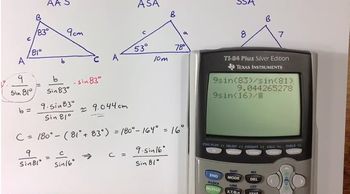Table of contents
- 0. Review of College Algebra4h 43m
- 1. Measuring Angles39m
- 2. Trigonometric Functions on Right Triangles2h 5m
- 3. Unit Circle1h 19m
- 4. Graphing Trigonometric Functions1h 19m
- 5. Inverse Trigonometric Functions and Basic Trigonometric Equations1h 41m
- 6. Trigonometric Identities and More Equations2h 34m
- 7. Non-Right Triangles1h 38m
- 8. Vectors2h 25m
- 9. Polar Equations2h 5m
- 10. Parametric Equations1h 6m
- 11. Graphing Complex Numbers1h 7m
7. Non-Right Triangles
Law of Sines
Problem 7.11
Textbook Question
Find each angle B. Do not use a calculator.
<IMAGE>
 Verified step by step guidance
Verified step by step guidance1
Identify the trigonometric function or relationship given in the problem. For example, if the problem involves a right triangle, consider using sine, cosine, or tangent ratios.
Express the given information in terms of a trigonometric equation. For instance, if you know the opposite and adjacent sides of a right triangle, you can use \( \tan(B) = \frac{\text{opposite}}{\text{adjacent}} \).
Use known trigonometric values or identities to solve for the angle. For example, if \( \tan(B) = 1 \), then \( B = 45^\circ \) because \( \tan(45^\circ) = 1 \).
If the problem involves special angles, recall the common angle values and their trigonometric ratios, such as \( 30^\circ, 45^\circ, \) and \( 60^\circ \).
Verify your solution by checking if the calculated angle satisfies the original trigonometric equation or relationship.
Recommended similar problem, with video answer:
 Verified Solution
Verified SolutionThis video solution was recommended by our tutors as helpful for the problem above
Video duration:
0m:0sPlay a video:
Was this helpful?
Key Concepts
Here are the essential concepts you must grasp in order to answer the question correctly.
Trigonometric Ratios
Trigonometric ratios are relationships between the angles and sides of a right triangle. The primary ratios are sine, cosine, and tangent, defined as the ratios of the lengths of the sides opposite, adjacent, and hypotenuse to the angle in question. Understanding these ratios is essential for solving problems involving angles and side lengths in triangles.
Recommended video:

Introduction to Trigonometric Functions
Inverse Trigonometric Functions
Inverse trigonometric functions, such as arcsine, arccosine, and arctangent, are used to find angles when the values of the trigonometric ratios are known. These functions allow us to determine the angle corresponding to a given sine, cosine, or tangent value, which is crucial for solving for angles in trigonometric problems.
Recommended video:

Introduction to Inverse Trig Functions
Angle Relationships in Triangles
In any triangle, the sum of the interior angles is always 180 degrees. This fundamental property allows us to find unknown angles when some angles are known. Additionally, in right triangles, the relationships between the angles can be explored using complementary angles, where the two non-right angles add up to 90 degrees, aiding in angle calculations.
Recommended video:

30-60-90 Triangles

 4:27m
4:27mWatch next
Master Intro to Law of Sines with a bite sized video explanation from Patrick Ford
Start learningRelated Videos
Related Practice


















